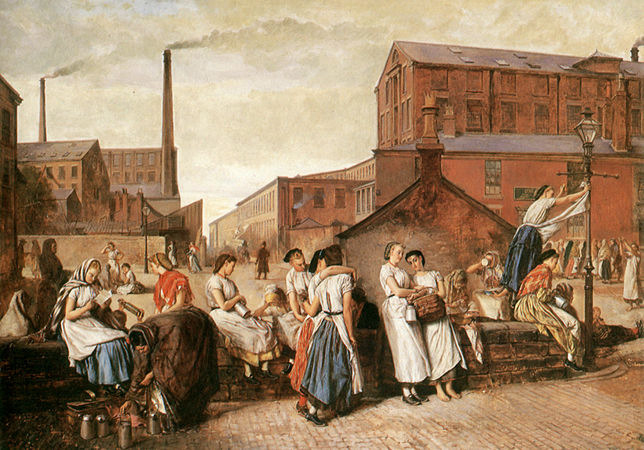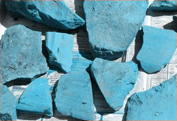
This fascinating painting of life in Victorian Wigan hangs in the City Art Gallery in Manchester. It was painted by the renowned Royal Academy artist Eyre Crowe in 1874, but how many Wiganers have seen it or even heard of it (I certainly hadn't until I wondered into the Art Gallery one bored shopping afternoon). A bit of home research reveals that it's a view of the Victoria and Britannia Mills looking down Miry Lane (some of the buildings actually still survive - Shearings Holidays for one). The view is from Wallgate in front of the canal terminal building, with the wall in the foreground (which no longer exist) being where the road splits off into Pottery Road.
Dismissed at the time for being "unpictorial" and "vulgar", Crowe's depiction of everyday life in a northern industrial town is now praised by modern critics for its realism and perception (the ancestor, perhaps, of L.S. Lowry's townscapes). I don't know about that - I just think it's great. (He did a second painting of Wigan called "The Spoil Bank" but I've yet to see it).
Ince Resistivity
Brian Parr has been continuing his work in the fields bordering the Higher Ince landfill site. He has now completed 18 survey grids on the two fields between the old Lancashire Union Railway embankment and the landfill fence-line. Most of these are 20m x 20m, with some variations to avoid thick outcrops of brambles and Japanese knotweed. Merging these grids will give coverage over some 100 metres across the anticipated line of the Roman Road. Brian has now moved on to the area between the landfill site fence-line and Seaman Way (where we took the soil sample for Anne Worsley).
Rectory Site
Last month we started work here in earnest. In preparation for our first excavation we have cleared a large area to the left of the entrance behind the gatehouse. What is crucial, however, as to where we can actually put our trenches in, will be the tree canopy coverage. Eric is therefore arranging to meet with Andrew Smallshaw, the Trees and Landscape Officer of Wigan Council, so that this can be determined. Eric has also arranged a place on site where we can store our equipment securely during the period of the project. Further work on site will be announced at our next meeting.
Church Yard Project
As mentioned at last month's meeting, we have been approached by Mark Adams, who is archaeological advisor to the Diocese of Liverpool. He wants to see if we interested in getting involved in a watching brief on work to be carried out in the grounds of All Saints Parish Church. The job in hand entails removing the existing pathway on the south side of the Church, a small reduction in ground level and replacing with new flags.
Mark thinks it is unlikely that anything significant will turn up but maybe it would be a useful opportunity to have a look at this part of central Wigan - perhaps it will give a snapshot of the character of the area. There is also potential for the current paving flags to include re-used gravestones which will need to be recorded.
(Behind the iron fencing, next to the Church, there is certainly an unrecorded medieval grave slab (see our website), but probably this lies outside the remit of this project.) Having spoken to 2 or 3 members who are interest in this work, I've now contacted Mark who says he will send us a working brief when the project gets the go ahead.
Next Meeting
Wednesday 3rd June - District Scout HQ (Baden Powell Centre) in Greenough Street as usual, starting at 7.30 pm. This month we have our very own Ian Trumble who will be telling us about the Prehistoric site at Star Carr in North Yorkshire. Ian worked there during his summer recess from his archaeological degree at Manchester University. Star Carr is considered one of the great sites of British archaeology. Situated near Scarborough it was first excavated in the 1940's. The range and quantity of finds dating to around 8700 BC, including red deer skulls turned into headdresses, has made it one of the outstanding sites in Europe. Anther remarkable find was a wooden trackway made of large split timbers leading to a platform by a lake where ritual objects were deposited. The items found have been in a remarkable state of preservation because of the boggy conditions on site. Although work continues here it is estimated that only 5% of it has so far been uncovered.
Sounds like a fascinating talk so hope to see you there B.A.
|



